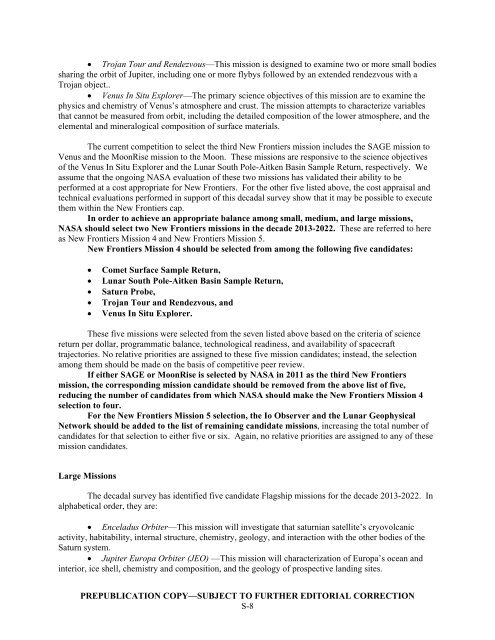Vision and Voyages for Planetary Science in the - Solar System ...
Vision and Voyages for Planetary Science in the - Solar System ...
Vision and Voyages for Planetary Science in the - Solar System ...
Create successful ePaper yourself
Turn your PDF publications into a flip-book with our unique Google optimized e-Paper software.
• Trojan Tour <strong>and</strong> Rendezvous—This mission is designed to exam<strong>in</strong>e two or more small bodies<br />
shar<strong>in</strong>g <strong>the</strong> orbit of Jupiter, <strong>in</strong>clud<strong>in</strong>g one or more flybys followed by an extended rendezvous with a<br />
Trojan object..<br />
• Venus In Situ Explorer—The primary science objectives of this mission are to exam<strong>in</strong>e <strong>the</strong><br />
physics <strong>and</strong> chemistry of Venus’s atmosphere <strong>and</strong> crust. The mission attempts to characterize variables<br />
that cannot be measured from orbit, <strong>in</strong>clud<strong>in</strong>g <strong>the</strong> detailed composition of <strong>the</strong> lower atmosphere, <strong>and</strong> <strong>the</strong><br />
elemental <strong>and</strong> m<strong>in</strong>eralogical composition of surface materials.<br />
The current competition to select <strong>the</strong> third New Frontiers mission <strong>in</strong>cludes <strong>the</strong> SAGE mission to<br />
Venus <strong>and</strong> <strong>the</strong> MoonRise mission to <strong>the</strong> Moon. These missions are responsive to <strong>the</strong> science objectives<br />
of <strong>the</strong> Venus In Situ Explorer <strong>and</strong> <strong>the</strong> Lunar South Pole-Aitken Bas<strong>in</strong> Sample Return, respectively. We<br />
assume that <strong>the</strong> ongo<strong>in</strong>g NASA evaluation of <strong>the</strong>se two missions has validated <strong>the</strong>ir ability to be<br />
per<strong>for</strong>med at a cost appropriate <strong>for</strong> New Frontiers. For <strong>the</strong> o<strong>the</strong>r five listed above, <strong>the</strong> cost appraisal <strong>and</strong><br />
technical evaluations per<strong>for</strong>med <strong>in</strong> support of this decadal survey show that it may be possible to execute<br />
<strong>the</strong>m with<strong>in</strong> <strong>the</strong> New Frontiers cap.<br />
In order to achieve an appropriate balance among small, medium, <strong>and</strong> large missions,<br />
NASA should select two New Frontiers missions <strong>in</strong> <strong>the</strong> decade 2013-2022. These are referred to here<br />
as New Frontiers Mission 4 <strong>and</strong> New Frontiers Mission 5.<br />
New Frontiers Mission 4 should be selected from among <strong>the</strong> follow<strong>in</strong>g five c<strong>and</strong>idates:<br />
• Comet Surface Sample Return,<br />
• Lunar South Pole-Aitken Bas<strong>in</strong> Sample Return,<br />
• Saturn Probe,<br />
• Trojan Tour <strong>and</strong> Rendezvous, <strong>and</strong><br />
• Venus In Situ Explorer.<br />
These five missions were selected from <strong>the</strong> seven listed above based on <strong>the</strong> criteria of science<br />
return per dollar, programmatic balance, technological read<strong>in</strong>ess, <strong>and</strong> availability of spacecraft<br />
trajectories. No relative priorities are assigned to <strong>the</strong>se five mission c<strong>and</strong>idates; <strong>in</strong>stead, <strong>the</strong> selection<br />
among <strong>the</strong>m should be made on <strong>the</strong> basis of competitive peer review.<br />
If ei<strong>the</strong>r SAGE or MoonRise is selected by NASA <strong>in</strong> 2011 as <strong>the</strong> third New Frontiers<br />
mission, <strong>the</strong> correspond<strong>in</strong>g mission c<strong>and</strong>idate should be removed from <strong>the</strong> above list of five,<br />
reduc<strong>in</strong>g <strong>the</strong> number of c<strong>and</strong>idates from which NASA should make <strong>the</strong> New Frontiers Mission 4<br />
selection to four.<br />
For <strong>the</strong> New Frontiers Mission 5 selection, <strong>the</strong> Io Observer <strong>and</strong> <strong>the</strong> Lunar Geophysical<br />
Network should be added to <strong>the</strong> list of rema<strong>in</strong><strong>in</strong>g c<strong>and</strong>idate missions, <strong>in</strong>creas<strong>in</strong>g <strong>the</strong> total number of<br />
c<strong>and</strong>idates <strong>for</strong> that selection to ei<strong>the</strong>r five or six. Aga<strong>in</strong>, no relative priorities are assigned to any of <strong>the</strong>se<br />
mission c<strong>and</strong>idates.<br />
Large Missions<br />
The decadal survey has identified five c<strong>and</strong>idate Flagship missions <strong>for</strong> <strong>the</strong> decade 2013-2022. In<br />
alphabetical order, <strong>the</strong>y are:<br />
• Enceladus Orbiter—This mission will <strong>in</strong>vestigate that saturnian satellite’s cryovolcanic<br />
activity, habitability, <strong>in</strong>ternal structure, chemistry, geology, <strong>and</strong> <strong>in</strong>teraction with <strong>the</strong> o<strong>the</strong>r bodies of <strong>the</strong><br />
Saturn system.<br />
• Jupiter Europa Orbiter (JEO) —This mission will characterization of Europa’s ocean <strong>and</strong><br />
<strong>in</strong>terior, ice shell, chemistry <strong>and</strong> composition, <strong>and</strong> <strong>the</strong> geology of prospective l<strong>and</strong><strong>in</strong>g sites.<br />
PREPUBLICATION COPY—SUBJECT TO FURTHER EDITORIAL CORRECTION<br />
S-8











